CHAPTER V - Upland Woods
A savannah is a grassland with a few scattered trees--more woody
than a prairie. If you could take a time machine and visit
Brazos County before permanent settlement, you would find exactly
that. Early settlers found the prairies and savannahs good
for agriculture. At one time Brazos County was almost
entirely planted in cotton. When the bottom fell out of the
cotton market in the late 1800's and early 1900's, many farms were
left to lie fallow. Native grasses returned, as did woody
species. With naturally-occuring fires suppressed and the
native grazers eliminated, the grasslands became more woody over
time, resulting in the closed-canopy woods present in much of the
county today.
As we enter the more dense, upland Post Oak Woodlands, Winged Elm,
Ulmus
alata, joins Post Oak as a major part of the canopy. This
elm has
smooth, pointed leaves and corky wings along the twigs. This makes
it
easy to tell from the Cedar Elm present in other areas of the
park.
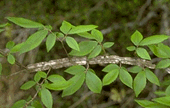
The Winged Elm flowers in early spring. Its pollen is highly
allergenic.

Here we can see the developing fruits which are called samaras.
They
mature quickly and fall almost immediately.

The Post Oak Woodlands has a definite understory layer. Much of
this
layer is composed of Ilex vomitoria, the Yaupon Holly.
Yaupon
is aggressive, and has contributed significantly to the process
of
thicketization in parts of Texas. Hollies are dioecious, which
means
that the male and female flowers are on separate plants. This
plant is
male--
its flowers have functional anthers.
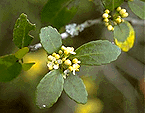
This is a female plant. The stamens are sterile, but they
gynoecium
is well-
developed.
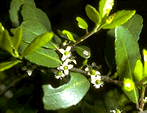
The bright-red fruits add color to the fall and winter landscape,
while the leaves remain green all year.

Another showy member of the understory community is Beauty
Berry, Callicarpa
americana. During spring and summer, it doesn't look like
much, but
in the fall it can be the most conspicuous thing in the
landscape.
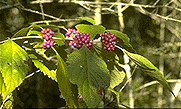
Unfortunately, the beautiful fuchsia berries aren't edible.
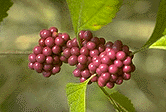
For edible fruit, we have to turn to the Farkleberry, Vaccinium
arboreum. It's in the same genus as the blueberry, and is
the only
member of the generally acid-loving Ericaceae that grows
naturally on
the local basic soils.
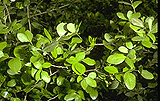
April sees the bushes covered with hundreds of tiny white bells.
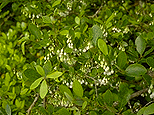
By autumn, these blossoms will be replaced by bluish
farkleberries.
They look very much like small blueberries. Fruit quality varies
greatly from plant to plant and from year to year. Even when plump
and
sweet, they tend to be a little seedy and not very flavorful.

Another group of plants with edible fruit is the Hawthorns. This
is Crataegus
marshallii, the Parsley-leaved Hawthorn. The Hawthorns are
difficult to work with taxonomically because they hybridize
readily and
can reproduce apomictically, creating populations with unusual
characteristics and uncertain affinities.
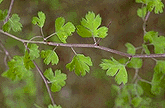
The white flowers can really stand out in the shade of the
understory.
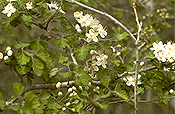
Hawthorns are small trees or large shrubs. As you can see, they
have
long, very sharp thorns. This is C.
crus-galli.
It is recognizable by its very shiny leaves and its extremely
long,
wicked thorns. In the fall, Hawthorns produce crops of small red
pomes.
They are tart but tasty, and make a very good jelly. They are an
important food source for the many species of birds in the park.
Commercial examples of pomes are apples and pears.
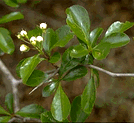
As we continue through the woods, our path leads us into and out
of
little open, sunny patches.
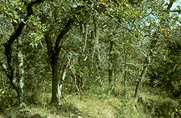
Chapter 6 - Mesic Woods
Lick Creek Park Field Trip Home Page